When should you maintain a fire hose cabinet, and when should you replace it?
Fire hose reels and racks are interesting pieces of fire protection equipment. The idea is this: in the event of a fire, building occupants can quickly reach the hose cabinet, extend the hose, and turn on the water to extinguish the fire. It’s a pretty simple concept that’s gotten a bit more complicated in recent years.
Once upon a time, these fire hose stations featured in many buildings, but now they see far more limited use. After reflecting on their safety, effectiveness, and the training needed to fight a fire, the fire protection industry now relies less on occupant-use fire hoses.
Documents like NFPA 14: Standard for the Installation of Standpipe and Hose Systems (2019 edition), the International Fire Code (IFC, 2021 edition), and the International Building Code (IBC, 2021 edition) still include references to firehose racks and reels but mandate them less often and include provisions for their removal.
To be clear: occupant-use fire hoses are still required in some situations. And if your building has these tools installed, it’s essential that you maintain them in working order. This article examines:
- When occupant-use fire hose stations are required by codes and standards
- What you need to do to maintain fire hose racks or reels
- Why you might choose to remove fire hose racks or reels, and when you are allowed to do so
Shop our selection of fire hose rack and reel supplies to keep your hose stations in working order. If you’re removing or altering hose stations, shop our selection of the hose valves, reducers, and caps you’ll need. But don’t modify your standpipe system without proper approval and code compliance.
Fire hose racks and reels may still be required in specific circumstances
The list of situations where occupant-use fire hoses are needed is actually very short. You need hose racks or reels if, according to local code, you have a Class II standpipe system not modified with firefighter hose connections or a Class III standpipe system in a building without a full sprinkler system and reducers and caps.
A standpipe system is a system of pipes that helps firefighters (and sometimes other personnel) extinguish a fire using connected hoses. It’s essentially like a network of internal fire hydrants that provides hose connections to facilitate deploying hoses and water close to blazes. There are three classes of standpipe systems: Class I, Class II, and Class III. Depending on the classification, a standpipe system provides 2-1/2” hose connections for firefighters, 1-1/2″ hose stations for occupant use, or both.
You’ll only ever find hose stations in Class II or Class III standpipe systems—Class I systems are just for firefighter use. Class II systems only have 1-1/2” occupant-use hose stations, though many have now been converted to firefighter use.
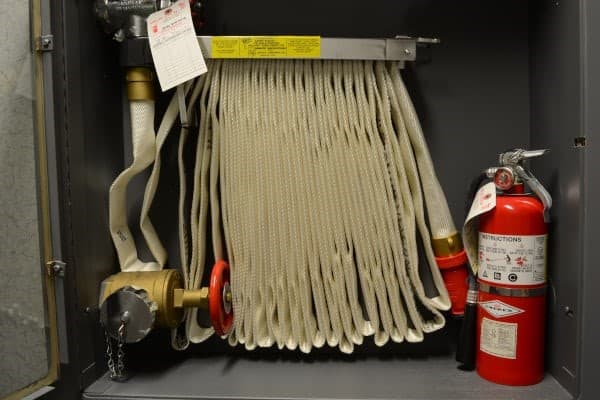
Class III standpipe systems often have both 2-1/2” hose connections for firefighters and 1-1/2″ hose stations for occupant use. However, the hose station requirement only applies when the building is unsprinklered. NFPA 14 removes the need for hose stations if the building is sprinklered and some hardware conditions are met:
5.3.3.2 Where the building is protected throughout by an approved automatic sprinkler system, Class II hose stations for use by trained personnel shall not be required, subject to the approval of the AHJ, provided that each Class I hose connection is 2 1/2 in. (65 mm) and is equipped with a 2 1/2 in. x 1 1/2 in. (65 mm x 40 mm) reducer and a cap attached with a chain.
The logic behind this rule is straightforward: host stations are for early-stage firefighting, and fire sprinklers fill that role more reliably than building occupants. Thus, you don’t need hose stations when the building is sprinklered, as long as each fire hose connection has a 2 1/2″ by 1 1/2″ reducer, allowing it to serve as a connection for either size hose.
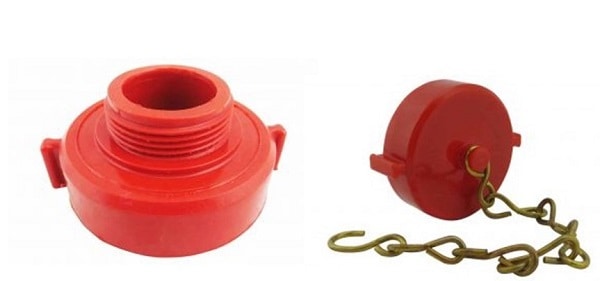
Since no new building under the 2015, 2018, or 2021 editions of the IBC needs a Class II standpipe system, the only new construction that may need occupant-use hose stations is a building that is not fully sprinklered with a Class III standpipe. And as we’ll discuss later, hose stations may only still be useful where the building plans to train occupants as part of an onsite fire brigade.
Staying compliant with occupant-use hose stations
Whether you’re installing or maintaining fire hose stations, there are a few rules you must follow. In this section, we’ll cover the requirements for:
- The sizing of hoses and hose connections
- The spacing and accessibility of hose stations
- The storage of hoses
- Signage
- Occupant training
Fire protection experts are skeptical of occupant-use hose stations, in part, because building owners often fail to maintain their stations and don’t train staff adequately (or at all) in their usage. This combination could be disastrous in the event of a fire. If you have fire hose stations, maintain them and train your staff properly.
Connection, hose, and nozzle requirements
For occupant-use hose stations, it’s essential to size the hose connection and the hose itself correctly.
NFPA 14’s requirements for hoses are found in section 4.6.2. Almost all hose used at fire hose stations has a diameter of 1 1/2″—the same as the hose connection. Non-professionals don’t have the training to handle the flow from larger hoses. Besides being the proper diameter, occupant-use hoses should be:
- Listed
- Lined
- Ready for use
- No longer than 100 feet
As long as they are 1 1/2″ in diameter, hoses may be collapsible (able to lay flat) or non-collapsible (maintaining their shape when stored).
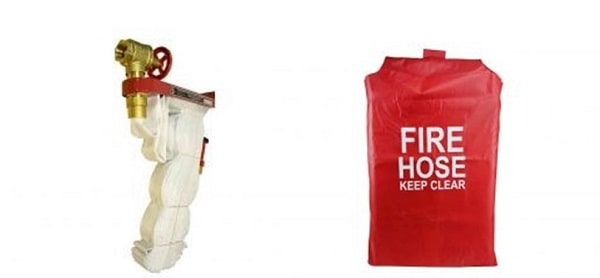
Smaller hoses are allowed in some circumstances. Specifically, hoses that are at least 1″ in diameter may be used in light-hazard occupancies when they are listed and meet the approval of the AHJ. These small hoses must be non-collapsible.
Spacing and accessibility of hose stations
Where they are used, hose stations provide an initial line of defense against fires—so they should be easy to reach and use in an emergency. If you have standard 1 1/2″ hoses, hose stations have to be within 130 ft. of any location in the building. If the hoses are smaller, they have to be closer—within 120 ft.
NFPA 14 also has rules for the accessibility of hose stations. In general, stations should be free from clutter, provide plenty of clearance around the hose connection, and be easy to open. Section 4.6.1 lists these requirements:
- Only fire protection equipment should be stored in cabinets and closets
- 2” of clearance must be provided between any part of the cabinet (excluding the door) and a hose connection at all times—even when the valve is fully opened
- Devices used to open “break glass” panels must be attached “in the immediate area” of the panel and “arranged so that the device cannot be used to break other glass panels in the cabinet door”
- Safety glazing must consist of tempered safety glass or plastic glazing conforming with ANSI Z97.1, a standard designed to reduce the likelihood of injury if glass breaks
Clear markings
You need to mark occupant-use hose stations clearly. If hoses are kept in cabinets or closets, these containers should have signage that indicates their content.
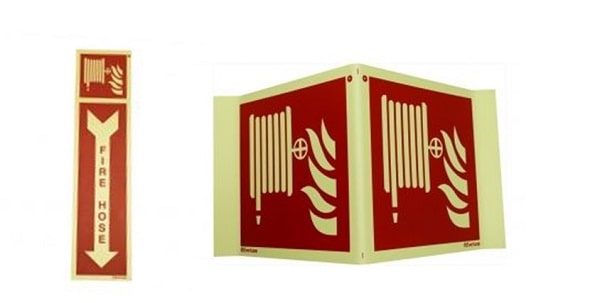
Additionally, per NFPA 14 section 4.6.5, the hose station should have hose operating instructions and the words “FIRE HOSE FOR USE BY TRAINED PERSONNEL.” These labels are often provided on the hose rack or reel, but you might have to affix them yourself.
Keeping staff trained—NFPA 600
Class II hose stations are meant for use by only trained personnel who typically aren’t firefighters. One reason that AHJs and fire protection experts often dislike hose stations is that employers and building owners too frequently neglect their training responsibilities. It could be disastrous to have complete novices fussing with a hose station in the event of a fire, especially if the building is unsprinklered.
Needless to say, you could be in trouble if an AHJ discovers your staff isn’t trained to use your hose stations. So how can individuals become qualified?
Aaron Johnson at The Code Coach explains that dedicated onsite fire brigades should be trained to the standards of NFPA 600: Standard on Facility Fire Brigades. Alternatively, staff expected to use a Class II station but who aren’t part of a dedicated fire brigade may be trained to the standards of the Fire Equipment Manufacturers Association (FEMA). Note that your local AHJ may have their own definitions of what constitutes “training” and which records you need to keep.
If training is too onerous for your operation, you need to look into the process for removing occupant-use hose stations while remaining compliant.
When you don’t need hose stations—and when you can replace them
As we’ve explained, fire hose stations are used less and less because they are often poorly maintained and the intended users are poorly trained—if at all. It’s often better to leave a fire to the professionals, instruct occupants to escape safely, and allow automatic sprinkler systems to do their job.
For this reason, there are situations where, subject to local code and approval from the AHJ, you can remove existing hose stations. IFC allows fire code officials to remove hose stations’ fire hoses if:
- The hose line won’t be used by trained staff or firefighters and
- The included hose outlets are compatible with the local fire department’s hoses
Additionally, NFPA 1: Fire Code authorizes local fire code officials to remove existing occupant-use hoses when all of the following conditions are met:
- NFPA 1 or current building codes don’t require their installation
- The authority having jurisdiction (AHJ) determines that the hose won’t be used by trained personnel or the fire department
So, when could you conceivably remove hose stations? Here are some example situations:
- A sprinklered building has a Class III standpipe with reducers and caps
- An unsprinklered building with a Class III standpipe is retrofitted with a complete sprinkler system, and reducers and caps are added to the standpipe system
- A Class II standpipe is modified to be a compliant Class I or Class III system
There is a cost-benefit analysis to be made here—do you maintain your hose stations and adequately train your staff, or do you perform renovations to install a sprinkler system or change the standpipe system? In historical buildings, such work could be very destructive. Also, hose stations have their place in certain settings. For instance, if hot work is a regular part of your operations, having hose stations nearby might be very useful.
But note this: since the 2018 edition, NFPA 1 gives AHJs a lot more latitude in forcing building owners to “remove Class II standpipes from buildings.” So, you might not have a choice.
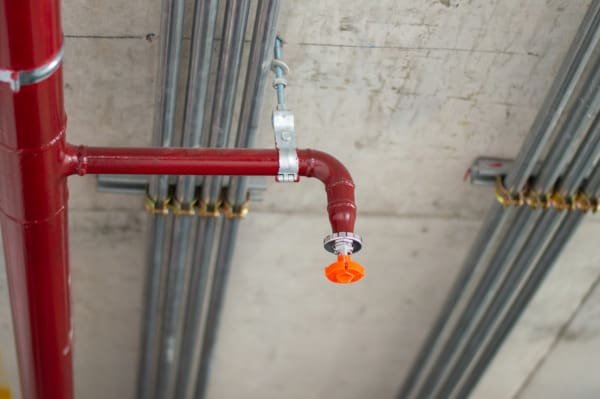
Fire hose racks and reels help trained, onsite personnel perform “first-aid” firefighting
In the right hands, occupant-use hose stations can be great tools. They let trained individuals precisely apply water to fire before professional firefighters arrive to use their much-bigger hoses. However, these hose stations are only needed in limited situations: uncommon Class II standpipe systems and Class III standpipe systems without full sprinkler systems.
If you have fire hose racks and reels in your building, it’s crucial to maintain them properly. This includes maintenance of the hoses themselves, plus staff education. However, given that different standards and codes make provisions to remove hose stations, altering the system may be an option. Check your local laws to find out what’s allowed.
This blog was originally posted at blog.qrfs.com. If this article helped you, check us out at Facebook.com/QuickResponseFireSupply or on Twitter @QuickResponseFS.


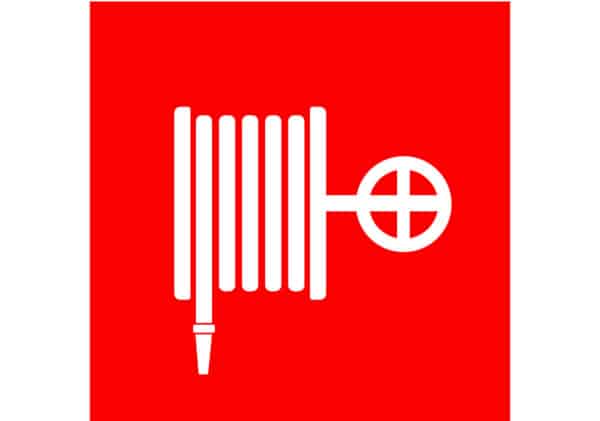
The cupboard in which our fire hose is stored, is slightly rusted on top edge, nevertheless can be easily opened, Does it need to be replaced Ed?
Paul — Maybe, maybe not, depending on the degree of rust and the judgment of your local authority having jurisdiction (AHJ). The following sections are from NFPA 25: Standard for the Inspection, Testing, and Maintenance of Water-Based Fire Protection Systems (2022 edition). Note item (1) under the first section:
If the rust is slight and doesn’t impact easy access to the cabinet or its operability, an AHJ conceivably might not regard it as a problem—but they also certainly could, technically speaking. You should ask your local AHJ for a more definitive answer. Thanks for reading!